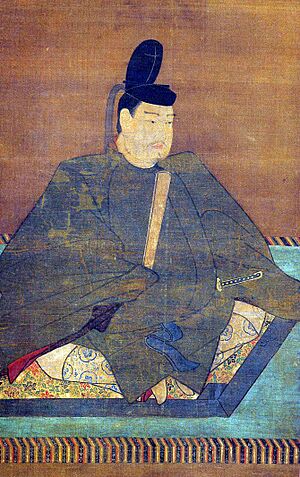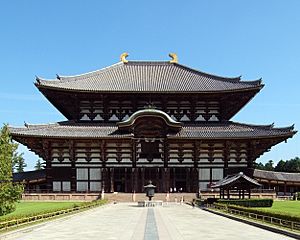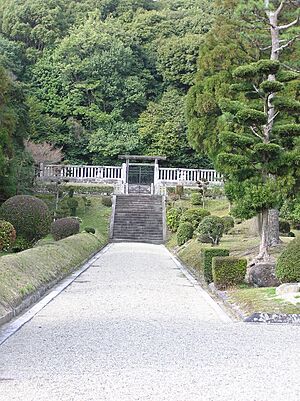Emperor Shōmu facts for kids
Quick facts for kids Emperor Shōmu聖武天皇 |
|||||
|---|---|---|---|---|---|

Portrait of Emperor Shōmu, 13th century
|
|||||
| Emperor of Japan | |||||
| Reign | March 3, 724 – August 19, 749 | ||||
| Predecessor | Genshō | ||||
| Successor | Kōken | ||||
| Born | Obito (首) 22 September 701 |
||||
| Died | 4 June 756 (aged 54) Nara, Japan |
||||
| Burial | Sahoyama no minami no misasagi (佐保山南陵) (Nara) | ||||
| Spouse | Fujiwara no Asukabe-hime | ||||
| Issue |
|
||||
|
|||||
| House | Yamato | ||||
| Father | Emperor Monmu | ||||
| Mother | Fujiwara no Miyako | ||||
| Religion | Buddhism | ||||
Emperor Shōmu (born September 22, 701, died June 4, 756) was the 45th emperor of Japan. He ruled from 724 to 749, during a time known as the Nara period.
Contents
Becoming Emperor of Japan
Before he became emperor, his personal name was Oshi-hiraki Toyosakura-hiko-no-mikoto. Shōmu was the son of Emperor Monmu and Fujiwara no Miyako. His mother was the daughter of a powerful leader named Fujiwara no Fuhito.
Shōmu had five main partners and six children. When his father died, Shōmu was still a child. So, his grandmother, Empress Gemmei, and his aunt, Empress Gensho, ruled before him.
- 724: Empress Genshō stepped down from the throne. Her nephew, Shōmu, then became the new emperor.
- January 31, 724: A new era name, Jinki, was chosen to mark Emperor Shōmu's rule.
- 735–737: A very serious smallpox disease spread across Japan. It caused many deaths, with about 25% to 35% of adults dying.
Emperor Shōmu continued to live in the Hezei Palace. He was the first emperor whose main partner was not from the imperial family. His partner, Kōmyō, was a commoner from the Fujiwara clan. A special government office was created just for the empress.
Emperor Shōmu's Journey to the East
In November 740, while a rebellion was happening, Emperor Shōmu left the capital city of Heijō-kyō (modern-day Nara). He traveled east with his court to a temporary palace in Kawaguchi. He might have been worried about his enemies in Nara. He also hoped his presence would stop other uprisings.
After four days of travel in heavy rain, they reached Kawaguchi on November 25, 740. A few days later, they heard that the rebellion had been stopped.
Even with the good news, Shōmu did not go back to Nara right away. He stayed in Kawaguchi until December 4, 740. He then continued his journey, traveling through different provinces. He finally reached Kuni in Yamashiro Province (modern-day Kizugawa) on January 6, 741. Kuni was a good place for defense, surrounded by hills and near a river. It was also linked to a powerful minister, Tachibana no Moroe, while Nara was a center for the Fujiwara family. On January 6, 741, Shōmu announced that Kuni would be the new capital city.
Key Events During Shōmu's Reign
Here are some important events that happened while Emperor Shōmu was in power:
- 724: Emperor Shōmu officially became emperor.
- 740: A rebellion led by Fujiwara no Hirotsugu started. An army was sent to stop it.
- 740: Hirotsugu's rebellion was defeated, and he was executed.
- 740: The capital city was moved to Kuni-kyō.
- 741: The Emperor ordered that special provincial temples be built all over Japan. These temples were called "kokubunji" for monks and "kokubunniji" for nuns. They were meant to protect the country and remove sins.
- 743: The Emperor ordered the building of the Daibutsu (Great Buddha) statue. This huge statue would later be placed in Tōdai-ji temple in Nara.
- 744: The court moved the capital again, this time to Naniwa-kyō.
- 745: The Emperor declared Shigaraki-kyō as the capital.
- 745: The capital moved back to Heijō-kyō (Nara), and work on the Great Buddha statue continued.
- 749: Shōmu, his empress, their children, and many important people went to Todai-ji temple. The emperor declared himself a follower of the three jewels of Buddhism: the Buddha, his teachings (Dharma), and the community of monks (Sangha).
- 749: After ruling for 25 years, Emperor Shōmu gave up his throne to his daughter, Princess Takano. She became Empress Kōken. After stepping down, Shōmu became a Buddhist priest. His empress, Komyo, also became a Buddhist nun.
- 752: A special ceremony called the Eye-Opening Ceremony was held at Tōdai-ji. This celebrated the completion of the Great Buddha statue.
Emperor Shōmu's Legacy
Shōmu was a very religious Buddhist. He is best known for ordering the creation of the huge 16-meter tall statue of the Vairocana Buddha. This statue is located in Tōdai-ji temple in Nara. Building this statue was a massive project. Some historians say it used up all of Japan's bronze and precious metals.
In 741, he also created the system of provincial temples across the country. This was the closest anyone came to making Japan an official Buddhist nation. He also made the ohigan holiday, celebrated during the spring and autumn equinox, a national observance.
Emperor Shōmu died when he was 56 years old.
The exact place where Shōmu is buried is known. This emperor is honored at a memorial Shinto shrine in Nara. His mausoleum is officially called Sahoyama no minami no misasagi. You can visit his tomb site today in Horenji-cho, Tenri City, near Nara City. The tomb of his empress, Empress Kōmyō, is also nearby.
The Shōsōin Treasure House
The Shōsō-in (正倉院) is a special treasure house at Tōdai-ji Temple in Nara, Japan. It holds about 9,000 items linked to Emperor Shōmu and Empress Kōmyō. It also contains many arts and crafts from the Tempyō era of Japanese history.
This treasure house is very important because it has many cultural items from the Tang dynasty period. These items came from Japan and other parts of Asia. They include furniture, games, musical instruments, clothes, weapons, Buddhist objects, and writings.
Eras of Shōmu's Life
The years of Emperor Shōmu's rule are known by different era names or nengō:
- Jinki (724–729)
- Tenpyō (729–749)
- Tenpyō-kanpō (749)
- Tenpyō-shōhō (749–757)
Family and Children
Emperor Shōmu had several partners and children:
- His Empress (Kōgō) was Fujiwara Asukabehime. She was the daughter of Fujiwara no Fuhito.
- Their second daughter was Imperial Princess Abe, who later became Empress Kōken.
- Their first son was Prince Motoi (727–728).
- Another partner was Agatainukai no Hirotoji.
- Their first daughter was Imperial Princess Inoe, who married Emperor Kōnin.
- Their third daughter was Imperial Princess Fuwa (723-795).
- Their second son was Imperial Prince Asaka (728–744).
See also
 In Spanish: Shōmu Tennō para niños
In Spanish: Shōmu Tennō para niños



